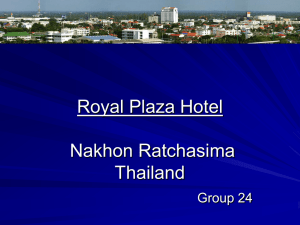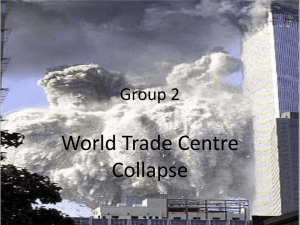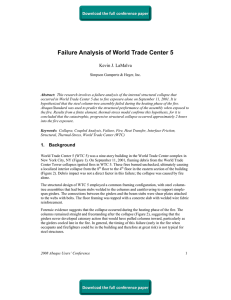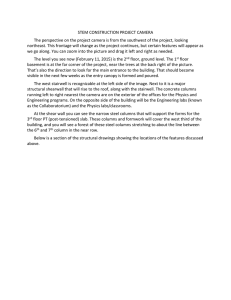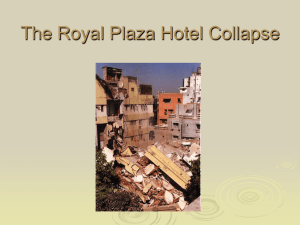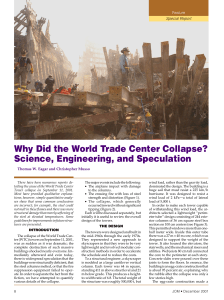wwt 3.doc
advertisement
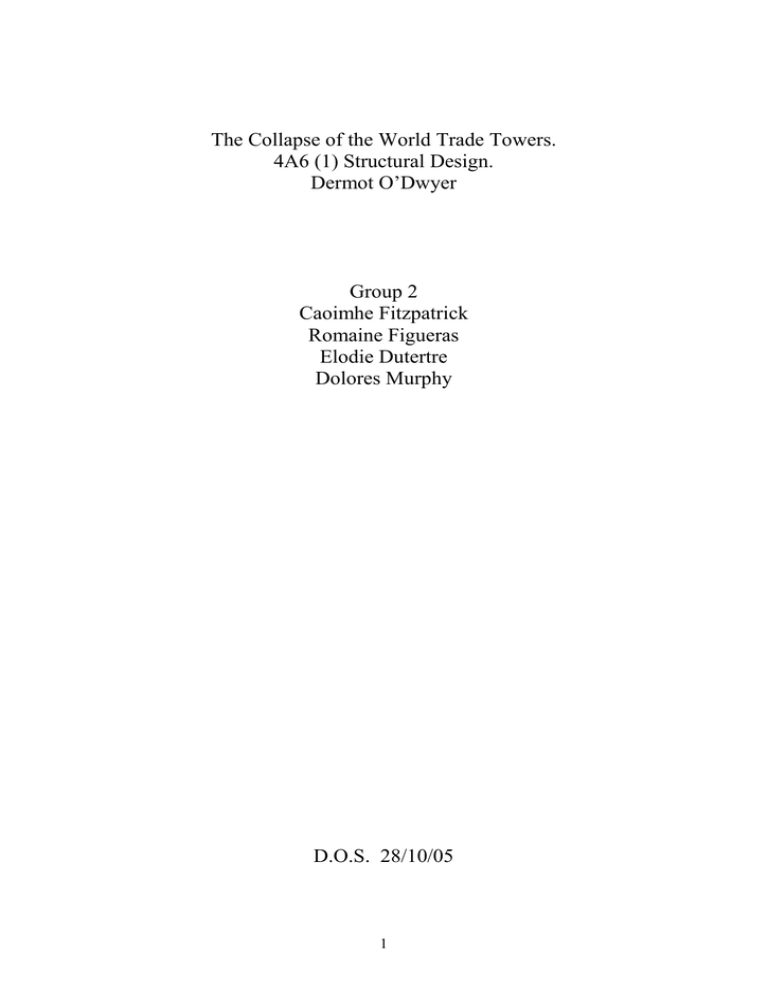
The Collapse of the World Trade Towers. 4A6 (1) Structural Design. Dermot O’Dwyer Group 2 Caoimhe Fitzpatrick Romaine Figueras Elodie Dutertre Dolores Murphy D.O.S. 28/10/05 1 Design The towers were designed in the mid-1960s. They represented a new approach to building skyscrapers. They were to be very lightweight and involved modular construction methods in order to accelerate the schedule and to reduce the costs. Each skyscraper was modelled as a large cantilever vertical column. Each tower was 64 m square, standing 411 m above street level and 21 m below grade. This produces a height-to-width ratio of 6.8. The total weight of the structure was roughly 500,000 t, but wind load, rather than the gravity load, dominated the design. It was designed to resist a wind load of 2 kPa—a total of lateral load of 5,000 t. In order to make each tower capable of withstanding this wind load, the architects selected a lightweight “perimeter tube” design consisting of 244 exterior columns of 36 cm square steel box section on 100 cm centres. This permitted windows more than one-half meter wide. Inside this outer tube there was a 27 m × 40 m core, which was designed to support the weight of the tower. It also housed the elevators, the stairwells, and the mechanical risers and utilities. Web joists 80 cm tall connected the core to the perimeter at each story. Concrete slabs were poured over these joists to form the floors. In essence, the building is an egg-crate construction that is about 95 percent air, explaining why the rubble after the collapse was only a few stories high! The egg-crate construction made a redundant structure (i.e., if one or two columns were lost, the loads would shift into adjacent columns and the building would remain standing). 2 The Impact The wingspan of a Boeing 767-200ER has a wingspan of approximately 48m, whereas each side of the WTC towers was approximately 64m. Each impact was roughly centred on a building face and consequently the corners of the buildings were relatively unharmed. However, several of the external columns were completely destroyed. The extent of the damage to the core is unknown. The force of the impact removed a significant amount of the fire retardant from structural elements. The fire of the WTC was no ordinary fire. It is known that the WTC fire was a fuel-rich, diffuse flame as evidenced by the copious black smoke. The WTC fire was fuel rich—hardly surprising with 90,000 L of jet fuel available. Factors such as flame volume and quantity of soot decrease the radiative heat loss in the fire, moving the temperature closer to the maximum of 1,000°C It is known that structural steel begins to soften around 425°C and loses about half of its strength at 650°C. This is why steel is stress relieved in this temperature range. But even a 50% loss of strength is still insufficient, by itself, to explain the WTC collapse. It was noted above that the wind load controlled the design allowables. The WTC, on this low-wind day, was likely not stressed more than a third of the design allowable, which is roughly one-fifth of the yield strength of the steel. 3 Even with its strength halved, the steel could still support two to three times the stresses imposed by a 650°C fire. However an additional problem was distortion of the steel in the fire. The temperature of the fire was not uniform everywhere, and the temperature on the outside of the box columns was clearly lower than on the side facing the fire. The temperature along the 18 m long joists was certainly not uniform. Given the thermal expansion of steel, a 150°C temperature difference from one location to another will produce yield-level residual stresses. This produced distortions in the slender structural steel, which resulted in buckling failures. The failure of the steel was due to two factors; 1. loss of strength due to the temperature of the fire, 2. Loss of structural integrity due to distortion of the steel from the non-uniform temperatures in the fire. The Collapse When multiple members fail in a building, the shifting loads eventually overstress the adjacent members and collapse occurs. Like a row of dominoes falling down this type of failure is known as progressive failure. The perimeter tube design of the WTC was highly redundant. It survived the loss of several exterior columns due to aircraft impact, but the ensuing fire led to other steel failures. With a 700 Pa floor design allowable, each floor should have been able to support approximately 1,300 t beyond its own weight. As the joists on one or two of the most heavily burned floors gave way and the outer box columns began to bow outward, the floors above them also fell. The floor below (with its 1,300 t design capacity) could not support the roughly 45,000 t of ten floors (or more) above crashing down on these angle clips. This started the domino effect that caused the buildings to collapse within ten seconds, hitting bottom with an estimated speed of 200 km per hour. If it had been free fall, with no restraint, the collapse would have only taken eight seconds and would have impacted at 300 km/h. 4 . 5 Factors Enhancing Structural Performance. The dense spacing of perimeter columns, coupled with deep spandrels, resulted in a robust building that was able to redistribute loads from severed perimeter columns, to adjacent intact columns. The robustness of and the large dimensional size of the towers also helped the buildings withstand the aircraft impact. The composite floor system enabled the floors to redistribute loads without collapse from places of aircraft impact damage to other locations, avoiding larger scale collapse upon impact. Potential Improvements There is far greater knowledge of how fires influence structures in 2005 than was the case in the 1960s.Thus we should use this knowledge to better ensure that fireproofing not dislodged or only minimally dislodged by aircraft impact. Her are some possible implementations Perimeter columns and floor framing with greater mass to enhance thermal and buckling performance. Thermally resistant window assemblies to limit air supply and retard the spread of fires; fire-protected and structurally hardened elevators for fire-fighter access with continuous, redundant water supply for standpipes). Steels with improved high-temperature properties (e.g., yield strength and stiffness) and creep behaviour. 6
